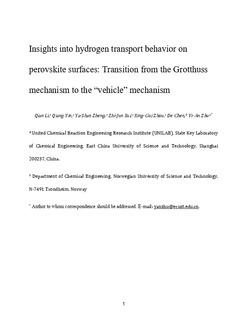| dc.contributor.author | Li, Qian | |
| dc.contributor.author | Yin, Qiang | |
| dc.contributor.author | Zheng, Ya-Shan | |
| dc.contributor.author | Sui, Zhi Jun | |
| dc.contributor.author | Zhou, Xinggui | |
| dc.contributor.author | Chen, De | |
| dc.contributor.author | Zhu, Yi-an | |
| dc.date.accessioned | 2020-02-05T11:55:45Z | |
| dc.date.available | 2020-02-05T11:55:45Z | |
| dc.date.created | 2019-11-21T15:00:50Z | |
| dc.date.issued | 2019 | |
| dc.identifier.issn | 0743-7463 | |
| dc.identifier.uri | http://hdl.handle.net/11250/2639800 | |
| dc.description.abstract | Hydrogen transport on transition-metal oxides is a shared process in many important physical and chemical changes of interest. In this work, DFT + U calculations have been carried out to explore the mechanism for hydrogen migration on the defect-free and oxygen-deficient LaMO3(001) (M = Cr, Mn, and Fe) surfaces. The calculated results indicate that hydrogen is preferentially adsorbed at the oxygen sites on all surfaces other than the defective LaCrO3(001), where the occupation of vacancies is energetically most favorable. The resultant O–H bonds would be weakened when oxygen vacancies are formed in their immediate vicinity because the increased electron density on the remaining ions would limit the ability of O to withdraw electrons from H. On defect-free LaMO3(001), hydrogen prefers to migrate along the [010] axis, during which the O–H bond is reoriented at the oxygen site for the hopping to proceed by the Grotthuss mechanism. In the presence of oxygen vacancies, the vehicle mechanism in which hydrogen hops together with the underlying oxygen would dominate on LaMnO3 and LaFeO3, whereas on the defective LaCrO3(001) the Grotthuss mechanism prevails. The linear scaling relations established show that the hydrogen and hydroxyl migration barriers decrease and increase, respectively, with increasing the strength of ionic bonding in perovskites, which provides a rational interpretation of the change in the preferred hydrogen migration mechanism. | nb_NO |
| dc.language.iso | eng | nb_NO |
| dc.publisher | American Chemical Society | nb_NO |
| dc.title | Insights into hydrogen transport behavior on perovskite surfaces: Transition from the Grotthuss mechanism to the “vehicle” mechanism | nb_NO |
| dc.type | Journal article | nb_NO |
| dc.type | Peer reviewed | nb_NO |
| dc.description.version | acceptedVersion | nb_NO |
| dc.source.journal | Langmuir | nb_NO |
| dc.identifier.doi | 10.1021/acs.langmuir.8b04138 | |
| dc.identifier.cristin | 1750594 | |
| dc.description.localcode | Locked until 29.5.2020 due to copyright restrictions. This document is the Accepted Manuscript version of a Published Work that appeared in final form in [JournalTitle], copyright © American Chemical Society after peer review and technical editing by the publisher. To access the final edited and published work see https://doi.org/10.1021/acs.langmuir.8b04138 | nb_NO |
| cristin.unitcode | 194,66,30,0 | |
| cristin.unitname | Institutt for kjemisk prosessteknologi | |
| cristin.ispublished | true | |
| cristin.fulltext | postprint | |
| cristin.qualitycode | 2 | |
